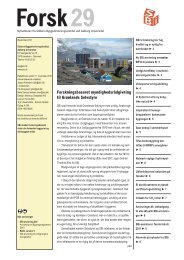CLEVELAND, OHIO (USA): THE TALE OF A SUPPLEMENTARY ...
CLEVELAND, OHIO (USA): THE TALE OF A SUPPLEMENTARY ...
CLEVELAND, OHIO (USA): THE TALE OF A SUPPLEMENTARY ...
Create successful ePaper yourself
Turn your PDF publications into a flip-book with our unique Google optimized e-Paper software.
<strong>CLEVELAND</strong>, <strong>OHIO</strong> (<strong>USA</strong>): <strong>THE</strong> <strong>TALE</strong> <strong>OF</strong> A<br />
<strong>SUPPLEMENTARY</strong> EMPOWERMENT ZONE<br />
W. Dennis Keating<br />
Professor and Associate Dean<br />
Levin College of Urban Affairs, Cleveland State University<br />
1717 Euclid Avenue, Cleveland, Ohio 44115 <strong>USA</strong><br />
Tel: (216) 687-2298<br />
Fax: (216) 687-9342<br />
E-mail: dennis@wolf.csuohio.edu<br />
Paper presented at the conference “Area-based initiatives in contemporary<br />
urban policy”<br />
Danish Building and Urban Research Institute and European Urban<br />
Research Association,<br />
Copenhagen, Denmark 17-19 May 2001<br />
1
Preface<br />
This paper briefly describes and analyzes the Supplemental Empowerment<br />
Zone program in Cleveland, Ohio, <strong>USA</strong> during the period 1995-2000. It is<br />
intended to complement the paper being presented by Robin Boyle and<br />
Peter Eisinger entitled “Empowerment Zones: Much Ado About Something in<br />
U.S. Urban Policy”, which provides an overview of the Empowerment Zone<br />
program initiated in the United States in 1994-95 by the Clinton<br />
administration. I was the leader of an evaluation team that followed the<br />
Cleveland program for Abt Associates and the U.S. Department of Housing<br />
and Urban Development (HUD) and is reflected in the as yet unreleased Abt<br />
report entitled “Interim Assessment of the Empowerment Zones and<br />
Enterprise Communities Program: A Progress Report”. The views of the<br />
author are not those of Abt Associates or HUD.<br />
2
Introduction<br />
Cleveland, Ohio is located on the shores of Lake Erie. Once the sixth largest<br />
city in the United States, it has experienced a lengthy decline over the past<br />
half-century. From a peak population of 914,000 in 1950, this fell to a<br />
reported 478,000 in 2000. This loss of population reflects the loss of<br />
manufacturing jobs, the decline of the central business district, and the<br />
general pattern of a suburban exodus from central cities that continues in<br />
metropolitan Cleveland (Bier 1994; Hill 1994, 1999). All of these trends have<br />
resulted in devastated neighborhoods and high rates of unemployment and<br />
poverty, exacerbated by racial tensions (Chandler 1999; Coulton and Chow<br />
1994). In 1967, Carl Stokes was elected mayor, becoming the first African-<br />
American mayor of a major U.S. city. Since 1989, Michael White has been<br />
the city’s second African-American mayor.<br />
White and his immediate predecessor, following the lead of Cleveland’s<br />
corporate leadership, have given a very high priority to the redevelopment of<br />
the city’s downtown. The city’s “Civic Vision” plan emphasizes the downtown<br />
as an employment center featuring financial services, retail, and<br />
entertainment. The city has sought to become a regional convention and<br />
tourist destination. Over the past decade, this has led to the building<br />
downtown of three new sports stadia (Keating , 1997), the Tower City officeretail<br />
complex, the Rock and Roll Hall of Fame Museum, and the Great<br />
Lakes Science Center, all heavily-subsidized by public funds. The city also<br />
seeks to promote new housing downtown, as well as in its residential<br />
neighborhoods. As a result of these activities, Cleveland has called itself the<br />
“Comeback City”, seeking to reverse its negative image from the Cuyahoga<br />
River fire of 1969 and its financial default in 1978 during the turbulent<br />
administration of populist mayor Dennis Kucinich (Swanstrom, 1985).<br />
However, other data and realities overshadow this effort to paint<br />
Cleveland in its best light. In the 1990s, the city continued to lose jobs as<br />
businesses left despite the offer of incentives, most notably British Petroleum<br />
(formerly Standard Oil of Ohio)’s North American headquarters office from its<br />
tower on Public Square in the heart of the city. In the past few months, the<br />
city’s last major steel works declared bankruptcy for the second time. In<br />
March 2001, the experienced the third rupture of an aging main water pipe in<br />
fourteen months.<br />
The poverty rate was over 40 percent citywide and much higher in some<br />
neighborhoods in the 1990s. The public school system has long been in<br />
crisis, subject first to supervision by the federal courts, then a takeover by<br />
the state of Ohio, and more recently being transferred to the control of the<br />
mayor of Cleveland. Its students are mostly poor and minority, with a dropout<br />
rate exceeding half of those students entering and some of the lowest<br />
scores reported in the state on standardized tests. It was only recently<br />
released from a federal court cross-town busing order designed to overcome<br />
past racial segregation. The city remains highly segregated by race, with<br />
only a few of its neighborhoods having any significant racial and ethnic mix.<br />
Much of the city’s housing is below code standards and the metropolitan<br />
housing authority which provides federally-subsidized low-income housing<br />
has long been in crisis, with its housing racially segregated, much of it in<br />
disrepair, and with long waiting lists due to limited funding and the ending of<br />
new construction by the federal government(Chandler 1994).<br />
In response to some of these conditions, Cleveland is home to many<br />
neighborhood-based community development corporations (CDCs), which<br />
have attempted to reverse the decline of the city’s neighborhoods. With the<br />
3
4<br />
assistance of the city, local philanthropic foundations, corporations, and<br />
banks, these CDCs have an impressive record of building and rehabilitating<br />
housing for lower-income residents and assisting the city in improving<br />
neighborhood commercial districts and retaining employers. The Cleveland<br />
Housing Network, a citywide CDC coalition, has gained national recognition<br />
for its accomplishments (Krumholz 1997).
The Empowerment Zone Program: Original<br />
Application, Goals and Programs<br />
When the U.S. Congress enacted the Clinton administration’s Empowerment<br />
Zone (EZ) program in 1994, Cleveland applied. While it met the criteria for<br />
the six major empowerment zones to be selected, it lost in this competition to<br />
its larger Midwest counterparts – Chicago and Detroit. However, despite the<br />
Republican takeover of the U.S. Congress in the November 1994 election,<br />
Cleveland’s longtime African-American Congressman Louis Stokes (the late<br />
Carl’s brother), even though now in the Democratic minority and soon to<br />
retire, was able to exert his considerable influence with the Clinton<br />
administration to gain a consolation prize for Cleveland. Moreover, Los<br />
Angeles, assumed to an obvious winner in this competition to offset the<br />
destruction of the 1992 South Central riot, also was not named as an Urban<br />
EZ, with the award of a full 10-year grant of $100 million in direct assistance<br />
and tax credits for EZ employers hiring area residents. Nevertheless, HUD<br />
decided in late 1994 to name Cleveland and Los Angeles “Supplemental<br />
Urban Empowerment Zones (SEZ)” (Gale 1996: 139).<br />
What Cleveland received was only $3 million in direct aid and $87 million<br />
through HUD’s Economic Development Initiative (EDI), intended to promote<br />
economic development in distressed cities through grants and loans to area<br />
businesses, but not the tax credits awarded to the six urban EZs. Cleveland,<br />
therefore, had to adapt its original proposal in order to be able to use this<br />
funding in its EZ.<br />
Cleveland selected four east side neighborhoods to comprise its<br />
supplementary EZ (see attached map). Three – Fairfax, Glenville, and<br />
Hough – are primarily residential and the fourth – the Midtown Corridor – is<br />
almost entirely commercial and industrial (including major businesses, the<br />
Cleveland Clinic hospital and cultural institutions like the Cleveland<br />
Playhouse). The population of the three residential neighborhoods is almost<br />
entirely black and mostly poor (see Appendix 1). For example, Hough, the<br />
site of a major riot in 1966 (Gale 1996: 42-44), saw its population<br />
subsequently drop from a high of 65,000 in 1950 to under 20,000 in 1990<br />
(Krumholz 1999: 93). Each of the four neighborhoods had a pre-existing<br />
CDC, supported by the city of Cleveland and their representatives on the<br />
Cleveland City Council – the Fairfax Renaissance Development Corporation<br />
(FRDC), the Glenville Development Corporation (GDC), Hough Area<br />
Partners in Progress (HAPP), and MidTown Cleveland.<br />
Cleveland’s strategy was to promote economic development in order to<br />
create jobs for EZ residents. To achieve this goal, it intended to use EDI<br />
funds to assist existing businesses located in the EZ and to attract other<br />
businesses to locate there, to use other funds for job training and placement<br />
assistance for unemployed residents, and to improve the housing,<br />
infrastructure and safety of the area to make it more attractive to both<br />
businesses and residents. One prominent example is the Church<br />
Square/Beacon Place mixed residential-commercial project in the heart of<br />
the EZ, where then Vice-President Al Gore unveiled the EZ initiative<br />
(Suarez 1999). To carry out the EZ programs, the city relied upon existing<br />
organizations, represented on a Citizens Advisory Council (CAC), to advise<br />
the city’s EZ office. These organizations included city agencies, other public<br />
institutions, and private organizations. This included a newly-initiated<br />
Cleveland Community Building Initiative launched by the Cleveland<br />
Foundation Commission on Poverty, operating in the Fairfax neighborhood.<br />
5
6<br />
In addition to HUD funds for economic development, the city also had its<br />
own programs and also hoped that a newly-opened community development<br />
bank (ShoreBank) located in the Glenville neighborhood would fund new<br />
enterprises employing EZ residents. The main innovations of the EZ<br />
program were a new loan program for small businesses and the introduction<br />
of a private security patrol in the EZ area, primarily serving businesses in the<br />
commercial districts. In addition to economic development, the other two<br />
major goals of the Cleveland EZ program were labor force development and<br />
community building.<br />
To achieve the former, the city contracted with several employment<br />
training/counseling agencies, most notably Job Match, established a new<br />
Center for Employment and Training (CET), and also expanded its own One<br />
Stop Career Center to the EZ area. Complicating the efforts to help<br />
unemployed and underemployed EZ residents to enter the work force was<br />
the 1996 enactment of federal welfare reform. As implemented in the state of<br />
Ohio, welfare recipients, primarily single women and their children, were<br />
limited in the future to only three years on welfare. This 3-year cut-off took<br />
effect in Cuyahoga County on October 1, 2001. This urban county, in which<br />
Cleveland is located, has the highest number of welfare recipients in the<br />
state of Ohio and a significant but unknown number live in the three<br />
residential EZ neighborhoods. Like the EZ program, Cuyahoga County<br />
embarked upon its own job training programs to assist recipients in finding<br />
work before they were cut off from welfare benefits.<br />
Further complicating efforts to find jobs for EZ residents in the economic<br />
boom times of the second half of the 1990s decade was the trend of new<br />
entry level jobs being created not only outside of the city of Cleveland but<br />
outside of Cuyahoga County. It has been estimated that fewer than 10<br />
percent of the expected annual new entry-level job openings in Cuyahoga<br />
County will be in the city of Cleveland. Whether seeking jobs in the suburbs<br />
of Cleveland within Cuyahoga County or outside of the county, many EZ<br />
residents have a very difficult time in reaching those jobs without owning a<br />
car. Public transit to these suburban work places is very limited. An<br />
experimental van service provided for former welfare recipients is tiny.<br />
Cuyahoga County even initiated an experimental subsidy program to help<br />
welfare recipients with job-related transportation problems purchase used<br />
automobiles.
EZ Assessment: 1995-2000<br />
The final interim assessment of Cleveland’s EZ was done in 2000, the<br />
midpoint of this 10-year program, as part of a national study of 18 cities. That<br />
report has not yet been released by HUD. As of 2000-2001, Cleveland has<br />
become a full-fledged EZ, with tax credits being made available to area<br />
businesses if they hire EZ residents. HUD has approved an expansion of the<br />
EZ area’s borders to allow more businesses to take advantage of these tax<br />
credits, should they choose to employ EZ residents.<br />
The first impediment to progress has been a regular turnover in<br />
leadership. During the period 1995-2000, the Cleveland EZ program had<br />
four different directors and all of the four CDCs in the EZ neighborhoods also<br />
had a change of leadership. In particular, HAPP in Hough had several<br />
directors and was suspended several times by the city’s Department of<br />
Community Development for alleged financial irregularities. The director of<br />
the city’s One Stop job training center was fired and ShoreBank went<br />
through several leadership changes. This turnover in leadership at all levels<br />
did not make for a smooth path in initiating and implementing innovative<br />
programs. The CAC also had several vacancies and did not play a very<br />
active role in either program direction or monitoring. Due to lack of funding,<br />
it and the EZ office failed to develop a 10-year strategic plan, as required by<br />
HUD. Therefore, the Cleveland EZ goals were mostly numerical.<br />
As of July 2000, the city reported to HUD that it had made $93 million in<br />
loans and $33 million in grants to EZ-located businesses, resulting in their<br />
investment of $89 million and the leveraging of a total of $235 million in<br />
private investment in the EZ area. The city projected providing financial<br />
assistance to 255 businesses and technical assistance to 350, with a little<br />
over 3,000 jobs for EZ residents created or retained resulting from these<br />
efforts. Without independent verification of these data, it is difficult to assess<br />
how much of the leveraged private investment can be attributed to the EZ<br />
program and the actual magnitude of the jobs claimed to be created.<br />
Job Match, a program of Vocational Guidance Services, reported training<br />
2,371 EZ residents and placing 2,028 of them in jobs, some of them more<br />
than once. However, Job Match also reported a significant attrition rate<br />
increasing three and six months after placement. HUD did not require<br />
reporting on job retention by EZ residents. Job Match has an overall 10-year<br />
goal of job placement for 10,000 EZ residents but had placed only about 20<br />
percent of that number after five years, rather than half. One deterrent to the<br />
use of this program is that the clients must take a mandatory drug test as a<br />
condition of participation. For this reason, many do not apply or drop out<br />
later. The city has not provided any additional drug counseling or treatment<br />
programs in the EZ.<br />
The CET program took awhile to organize. It only began training EZ<br />
residents in 1998 for welding and general machine work. It reported in<br />
September 1999 that 32 EZ residents had participated in these programs,<br />
with 25 graduates being placed in jobs. The city’s new One Stop career<br />
center opened in the EZ area in April 1998 but due to the controversy<br />
surrounding the firing of its director, information about its operations and<br />
impact were not available. The impact of Cuyahoga County’s job training<br />
programs for EZ welfare recipients also could not be determined because<br />
such data are not available.<br />
After five years, the overall impact of the EZ program on increasing<br />
employment and reducing poverty in its three residential neighborhoods is<br />
not impressive. At best, it is possible that as many as 5,000 residents<br />
7
8<br />
obtained or retained jobs, mostly low-wage entry jobs, whether in the EZ<br />
area or elsewhere. However, these data are hard to verify. It is also unknown<br />
just how many of those who did obtain jobs retained them after 3-6 months.<br />
Little is known about the activities of ShoreBank and its business<br />
incubator located in the Glenville neighborhood. To date, no EZ businesses<br />
have applied for tax credits for employing EZ residents. Many small<br />
businesses within the EZ, especially minority-owned, have not applied for or<br />
received EZ loans and grants. The reasons include their inability to develop<br />
business plans, past debts including unpaid taxes that make them ineligible,<br />
and reluctance to become involved in this government program. This is<br />
despite the availability of business development specialists through the four<br />
CDCs. And, there is no evidence of many new businesses developing or<br />
relocating in the EZ area, with the one exception of an assisted-living<br />
employer that relocated its office from a nearby suburb. The Midtown<br />
Corridor does have ambitious plans for the development of a bio-tech park<br />
but that remains in the future and even if it materializes it is not clear that it<br />
would employ that many unskilled or low-skilled EZ residents.<br />
The EZ can and does point to several new housing developments within<br />
the EZ sponsored by the three residential CDCs, with a total investment of<br />
$110 million. However, it is likely that they would have been constructed<br />
anyway using various public subsidies and private investment available to<br />
CDCs throughout the city.
Conclusion<br />
The goals of Cleveland’s EZ program were well intentioned. They included<br />
the creation of jobs sufficient to significantly reduce unemployment and<br />
poverty among its residents, almost all of whom are African-American, and<br />
to improve the physical, social and economic conditions of its four<br />
neighborhoods. The hope was that financial assistance provided to<br />
businesses, especially those in the Midtown Corridor with its many major<br />
employers, would spur their employment of residents, whose job readiness<br />
would be provided through a combination of existing and new job training<br />
and placement agencies located in or near to the EZ area. Instead of<br />
creating new entities, Cleveland chose to rely almost exclusively on existing<br />
agencies, both public and private, other than the creation of its own EZ office<br />
and the CET.<br />
As the above narrative recounts , many factors combined to frustrate the<br />
achievement of those goals over the first five years of this program. This was<br />
in spite of relatively prosperous economic times. Allowing for the necessary<br />
initial time for organization of EZ programs and considering the turnover in<br />
key leadership, the results are still disappointing. This is partly due to<br />
Cleveland’s forced reliance upon very limited economic incentives that<br />
require businesses to take out loans, rather than receive grants only, in order<br />
to receive assistance from the EZ programs. The absence of tax credits<br />
may have been a factor, although small businesses are unlikely to be able to<br />
take advantage of them anyway.<br />
Whether that many EZ residents will be able to obtain new jobs and<br />
improve their personal situation for long remains to be seen, especially if<br />
most of those jobs are outside the EZ. The cumulative losses in welfare<br />
benefits previously received by many of those EZ residents could largely<br />
offset the economic gains from the EZ programs, particularly since their jobs<br />
are mostly paying just above minimum wage ($6-7 per hour), may not<br />
provide health care, disability and retirement benefits, require the mothers to<br />
find and pay for private child care (which the city and the county have not<br />
provided on a major scale), and often involve transportation costs that are<br />
not subsidized by employers (and only temporarily, if at all, by public job<br />
assistance agencies). The EZ also has some fledgling programs aimed at<br />
improving public education for children in the EZ-located public schools but<br />
this has more long range than short term implications.<br />
Therefore, it must be said that Cleveland’s ambitious EZ program has not<br />
been sufficiently funded or effectively implemented to date so as to reach its<br />
fairly modest goals. With a new and conservative Bush administration now in<br />
office and a recent downturn in the U.S. economy, the prospects for<br />
increased federal assistance to areas like Cleveland’s EZ area do not seem<br />
bright. Finally, to the extent that the EZ program does provide jobs for EZ<br />
residents, it is unknown whether they will stay in its neighborhoods, even if<br />
improved with new housing and additional services like increased security. If<br />
the result would be the departure of the most energetic and able of the EZ<br />
residents, especially if their new jobs are located outside of the EZ area, it<br />
becomes doubtful as to whether the overall impact would necessarily be<br />
beneficial to the EZ residential neighborhoods if the poorest, most<br />
dependent and least employable residents are left behind.<br />
9
BIBLIOGRAPHY<br />
Bier, Thomas E. 1994. “Housing Dynamics of the Cleveland Area, 1950-<br />
2000” in W. Dennis Keating, Norman Krumholz, and David C. Perry, eds.<br />
Cleveland: A<br />
Metropolitan Reader. Kent, OH: Kent State University Press.<br />
Chandler, Mittie Olion. 1994. “Politics and the Development of Public<br />
Housing” in Keating, Krumholz and Perry.<br />
Chandler, Mittie Olion. 1999. “Race Relations in Cleveland” in David C.<br />
Sweet, Kathryn Wertheim Hexter, and David Beach, eds. The New American<br />
City Faces Its Regional Future: A Cleveland Perspective. Athens, OH: Ohio<br />
University Press.<br />
Coulton, Claudia J. and Julius Chow. 1994 “The Impact of Poverty on<br />
Cleveland Neighborhoods” in Keating, Krumholz and Perry.<br />
Gale, Dennis E. 1996. Understanding Urban Unrest. London: Sage<br />
Publications.<br />
Hill, Edward W. 1994. “The Cleveland Economy: A Case Study of Economic<br />
Restructuring” in Keating, Krumholz, and Perry.<br />
Hill, Edward W. 1999. “Comeback Cleveland by the Numbers” in Sweet,<br />
Hexter and Beach.<br />
Keating, W. Dennis. 1997. “Cleveland: the Comeback City” in Mickey Lauria,<br />
ed. Reconstructing Urban Regime Theory: Regulating Urban Politics in a<br />
Global Economy. London: Sage Publications.<br />
Krumholz, Norman. 1997. “The Provision of Affordable Housing in<br />
Cleveland” in Willem van Vliet, ed. Affordable Housing and Urban<br />
Redevelopment in the United States. London: Sage Publications (Urban<br />
Affairs Annual Reviews 46).<br />
Krumholz, Norman. 1999. “Cleveland: the Hough and Central neighborhoods<br />
–Empowerment Zones and other Urban Policies” in W. Dennis Keating and<br />
Norman Krumholz, eds. Rebuilding Urban Neighborhoods: Achievements,<br />
Opportunities, and Limits. London: Sage Publications.<br />
Suarez, Ray. 1999. The Old Neighborhood. New York: the Free Press.<br />
Swanstrom, Todd. 1985. The Crisis of Growth Politics: Cleveland, Kucinich,<br />
and the Challenge of Urban Populism. Philadelphia: Temple University<br />
Press.<br />
Appendix 1: 1990 Profile of the Three Residential EZ Neighborhoods<br />
(Source: 1990 U.S. Census)<br />
Neighborhood Population %Black %Poverty Rate (Families)<br />
%Unemployment<br />
10<br />
Fairfax 8,973 98 50 26
Glenville 25,845 97 39 24<br />
Hough 19,715 97 55 30<br />
11

















